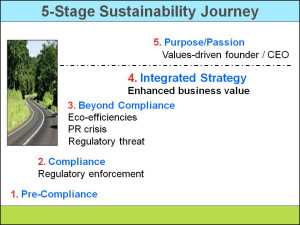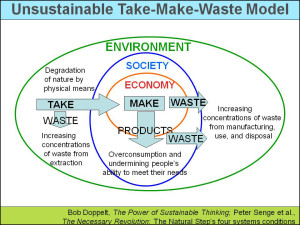A big adjustment from our old house, where I had turned the granny quarters (a fully equipped kitchen) into a studio and where my husband had a room so large that he added useless furniture to fill the space... the kids did find it useful to draw on the lounge chair with markers though. It was so easy back then to just close his office door, when I could no longer stand the sight of his pile-scattered floor (Scott is a compulsive “piler”). And in my space, it was also too easy to collect used frames found at garage sales. I had high hopes of using them to exhibit my art, but they never actually “helped” my artwork. In our separated offices, we both had a stapler, we both had a shelf for office supplies, we both had a printer, we both had a TV… we both had a refuse can: one labeled “trash”, not “recycling”. Paper, food, pictures, plastic bags, packaging, all went in the same bin, destined to landfill.
How did we ever think that recycling should be relegated to the kitchen only?
Boy, have we come a long way in the past 5 years. In our new (1920’s) small home, we’ve learned to share, for the better… a more streamlined and more sustainable office. (Bonus: una officina to clean, not dos!). It’s not yet perfect as we still have to deal with long-ago purchases and their imminent disposal: Food coloring containers which await to color my homemade paper, large artist acrylic paint jugs, adhesive spray can, etc. I am not sure how I will choose to sustainably replace these products (make my own, or find them used on craigslist perhaps?), if replace them at all, when I empty them. In the meantime, I am reminded everyday of the wasteful office life we use to lead, and look forward to putting it behind me, with no visual reminders.
Here are some of the things we have done to get us on the right track in our current home office:
Pens / pencils:
REFUSE
o Better to have one good pen than a dozen “cheapies”. Thru my simplifying business, I have witnessed homes filled with dozens of free business pens. If you have allowed them in your house, you have also created a demand for it. Help stop the free-pen madness.
o Teach your kids to REFUSE pencils as party favors, as homes can get filled with those too.
REUSE
o If you do need a pen or a pencil, choose a stainless refillable model, and buy them from a stationary store: they come unpackaged.
o Use refillable white board markers (
Auspen): we don't personally own them since we're still using those from our previous life, but we've seen them at the
SF Green Festivalo Donate extra office material (paper, pencils) to your public school's art program.
Paper:
REFUSE
o Start your own
junk mail war
o Cancel your phone directories: available online anyways
o Request less paper from your kids teachers/school and refuse duplicates when you have more than one child.
o Refuse paper billing (and it would be nice if we could keep it at that;)…sign up for electronic bills and statements. Call them as soon as you open their mail.
REDUCE
o Buy recycled paper products, packaged in paper: some manufacturers choose to sell their reems in plastic (?????)
REUSE
o Use single-side printed paper for printing or making notepads with a metal clip: dedicated a file or paper tray for it
o Collect and use junk mail response envelopes
RECYCLE
o Ditch the trash can (use it as a receptacle for your goodwill donations): strive to use your recycling bin exclusively, an office is all about paper management.
Shipping:
REFUSE:
o Request recyclable-only packing material from your shippers: refuse bubble wrapping, styrefoam and plastic bags.
REDUCE:
o Use paper tape on your parcels, and masking tape for smaller uses. I confess, it was a hard switch for me. There was something comforting about protecting my shipping addresses behind a waterproof plastic tape.
o Buy lick-on stamps instead of stick-on’s (if and when possible). At this point USPS only has $1 lick-on stamps available, so we're left with a sticker sheet the rest of the time (landfill).
Send them an emailto help bring the lick-on's back in fashion.
o Use
USPS.com to print postage directly on your envelopes.
o Use surface mail to reduce the carbon footprint of your posted items.
REUSE:
o If you shred paper (we don’t because of the added energy cost and extra machine laying around), reuse the shredded material for shipping or COMPOST it: shredded paper is a nightmare for recyclers to separate if you have a mixed recycling can.
o Use a return address stamp instead of stickers (the latter leaves you with a non-recyclable sticker sheet destined for landfill): you already cancelled the pesky charity themed address labels, right?
o Reuse packaging material: donate your bubble wrap (with no tape), peanuts, entire styrofoam pads to
UPS, dedicate a cabinet for the rest and reuse it.
Other Supplies/Equipment:
REDUCE:
o Use paper clips instead of staples, or a
staple-free stapler(packaging is ¾ cardboard, ¼ plastic). I personally don’t have one yet, I can't get past all the packaging.
o Buy paper clips in bulk: bring a
bulk bag to
Staples, they have a great selection of such items sold by the weight.
o Use solar powered calculator (looks like they still make battery operated ones...)
REUSE
o Use your library to read business magazines and books. Sell your books on amazon.com (you’ll be amazed how much you can sell your old schoolbooks) or donate them to your library for other people to enjoy them.
o Use memory sticks and external drives instead of CD’s (they last longer than the rewrittables too)
RECYCLE:
o Only print when absolutely necessary, recycle your cartridges (at Best Buy for example) keep a receptacle next to your printer for easy recycling.
o Donate your unused computers/equipment to Goodwill. They will refurbish and resell the equipment if possible. And, if buying a new computer, get a laptop, it’s more energy efficient.
o Cell phone: repair or donate.
Best Buy will take them.
Operations:
o Use
zero waste cleaning (recipes coming up next week!).
o
Smart strip your equipment if you can. Since it did not work for our system, we have strategically plugged our equipment in power strips that we turn off at the end of the day.
o When your bulb burns out replace them with CFL’s (duh).
 So, how can you make sustainability personal and create the best conditions and incentives for engagement?
So, how can you make sustainability personal and create the best conditions and incentives for engagement?





